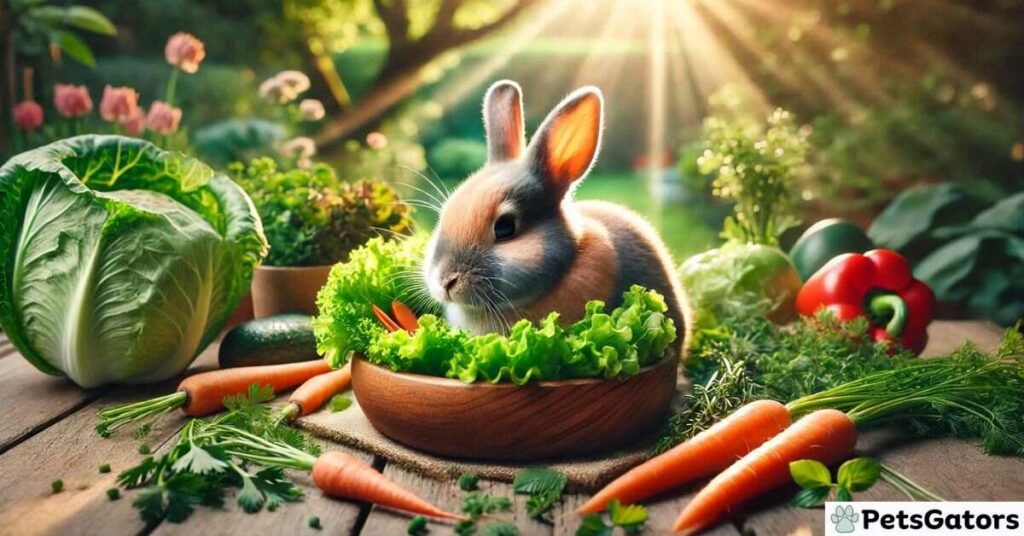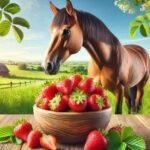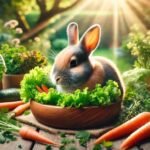Introduction
Feeding them with a hay diet, green fodder, and fresh vegetables, completely devoid of pellets is how wholesomely and naturally it could feed a rabbit. This is basically mimicking the kind of diet a rabbit would have in the wild. Shows how nutrient-rich, fiber-heavy food is paramount to optimum health and digestion.
A rabbit has a highly sensitive digestive system, the performance of which depends on the diets consisting mostly of fiber. Commercial pellets, however, provide easier access to food, but most of them have fillers and processed ingredients that might not support a rabbit’s nutritional requirements. Feeding your rabbit pellet-free helps in hydration and good dental health while mimicking natural foraging behavior in general, contributing to the overall well-being and happiness of your rabbit.
What is a Pellet-Free Rabbit Diet?
A pellet-free diet for pet rabbits emphasizes mimicking as closely as possible the diet naturally available to their wild counterparts. Beyond commercial rabbit pellets, the diet comprises fresh hay, leafy greens, herbs, and the occasional topping of veggies.
Wild rabbits would scavenge grass, weeds, and other forage. That kind of eating pattern really helps keep a digestive tract and teeth health in check. A similar benefit is likely to be experienced by domestic rabbits sweating off store-bought pellet foods-from the nutritional standpoint to avoiding potential dangers found in processed feed.
However, it is one of the most critical parts of the entire project with careful planning of knowledge necessary on a rabbit’s nutritional needs. The aim is, of course, to have a fiber, vitamin, and mineral balance without relying on the convenience of pre-formulated pellets at the same time.
Why Choose a Pellet-Free Diet?
There are some complementary reasons, simply related to health, ethics, and cost, as to why most of the rabbit owners have turned away from pellets:
- Natural eating habits: Mimicking a rabbit’s natural grazing can encourage better digestion as well as mental stimulation.
- Avoiding processed ingredients: Pellets typically contain fillers, preservatives and sugars which may not fit well into a rabbit’s nutrition.
- Preventing health issues: A natural fiber-rich diet prevents excessive weight gain, dental problems, and digestive ailments such as GI stasis.
- Ethical concerns: Some owners would also not want to support industries connected with processed pet foods.
How Much Hay Should Your Rabbit Eat Daily?
Hay should never be less than unlimited for rabbits. It is a daily intake of 80-and-higher percentages of hay all day, thereby promoting their continuously running digestive system and their natural teeth trimming. Have hay, always fresh and clean, with periodic changes to avoid mold development or contamination. Vegetables boost vital vitamins and minerals to the hydration needs of a rabbit.
1. Best Vegetables for Rabbits
Here is a breakdown of the vegetables mentioned and their suitability for rabbits:
- Romaine Lettuce:It is not radiant and also never in nourishment for rabbits; it contains less water than iceberg lettuce, which makes it vitamin A and K rich.
- Kale:A lot of fiber, calcium, and vitamins but should be given sparingly owing to the high calcium content.
- Spinach: Nutritionally packed and safe in small amounts; however, it bears high risk of oxalate so it is better given occasionally.
- Watercress:Contains important vitamins namely A and C that are of healthy treats for rabbits when served in moderation.
- Broccoli: Can be fed in small portions; the leaves and stems are more appropriate for rabbits than the florets because they can egg on gas.
- Carrot Tops:Rabbits love them, actually. For carrot tops are nutrient thieves, and they are healthier alternatives than the actual carrot root, which contains lots of sugar.
Vegetables to Avoid
Not all vegetables may be good for rabbits.
- Iceberg lettuce: Keep away from – Contains lactucarium, which leads to diarrhea.
- Potatoes and corn: Mainly starch and can cause blockages in the digestive system
- Onions: Poisonous to rabbits; can also cause anemia.
Types of Hay Suitable for Rabbits
Different types of hay bring unique benefits:
- Timothy Hay: Definitely the adult gold standard for hay – high in fiber and low in protein.
- Orchard Grass: Soft for those rabbits with a more delicate chewing style than timothy hay.
- Meadow Hay: Well mixed with grasses and wild plants, providing a range of texture and taste.
- Alfalfa Hay: Not suitable for other than growing babies for all the calcium and protein content, but avoided in adults owing to urinary problems.
Read Previous – Do rabbits mate for life
Ensuring Nutritional Balance Without Pellets
1. Meeting Fiber Requirements
Fiber is the single most important aspect of the diet of a rabbit. Fiber smoothens the entire digestive tract and also keeps away some very dangerous conditions from the animal like GI stasis. Stuffing the high-fiber hay with fibrous vegetables like kale and spinach will serve the purpose.
2. Supplementing Essential Nutrients
Heavily supplemented with hay and fresh foods, still, some nutrients will not fulfill requirements.
3. Sources of Calcium
Calcium is needed by rabbits so that they can maintain their teeth and bones strong. But excess calcium can lead up to urinary problems like bladder sludge. Moderate sources include:
- Parsley
- Collard greens
4. Vitamins A and D
- Vitamin A: Necessary for vision and immunological health. Found in carrots (in limited amounts) and in leafy greens like spinach.
- Vitamin D: However, the rabbits can produce this vitamin from sunlight, so it needs to be put in inderect exposure for small periods of time.
Common Challenges and How to Overcome Them
1. Dealing with Picky Eaters
To change your pet’s diet from pellets to a natural diet, it will take time and require you to reduce the pellets in the diet gradually while hay and vegetables are increased. You can also add fragrant herbs such as basil or mint for pets that refuse to eat.
2. Avoiding Overfeeding Fresh Foods
Overfeeding on vegetables can upset the digestive system; hence it should be done with a particular formula, which comprises about 80% for hay, 15% for vegetables, and 5% for herbs or treats.
3. Managing Costs and Sourcing Ingredients
- Buying in bulk: Purchase hay in larger quantities to save money.
- Growing your own: Cultivate rabbit-safe herbs and vegetables in a garden or windowsill planter.
FAQs
Can Baby Rabbits Thrive on a Pellet-Free Diet?
Yes, baby rabbits can grow without pellets given the right nutrition. They need alfalfa hay that gives them protein and calcium required for their growth. Also, supplement this with high calcium greens like parsley or kale so that their developing bones receive more nutrition. You must always ensure that there is fresh water and gradually change their diet for optimal health.
Are Fruits Safe to Include in a Pellet-Free Diet?
Fruits may well have occupied the rabbit’s pellet-less diet but should be given very moderate portions. Fruits such as those that very high in sugar: like the apples, bananas, or berries would be for a rare treat. Too much fruit can cause digestive upset and lead to an owl-like figure.
Can Rabbits on a Pellet-Free Diet Still Get Enough Protein?
Sure, they can live without a pellet diet; a good mixture of foods alone will meet the protein needs of rabbits. Young rabbits require alfalfa hay, while adults are better off with timothy hay along with high-nutritional-value leafy greens. A variety of food intake on a daily basis will ensure all other nutrients are consumed by these animals.
Conclusion
A great way to keep your rabbit healthy and natural is to switch him onto a totally pellet-free diet. A wholesome diet may consist of fresh vegetables, a variety of leafy greens, and unlimited amounts of hay to meet the nutrient requirement while promoting improved digestion and the dental health of the pet.
This may simulate natural foraging behavior and a rabbit’s natural diet while reducing reliance on processed feeds. With a little planning, such a diet can assist in having a furry friend that is happy, active, and lasts for years.
Stay connected and updated with – PetsGators.com!







